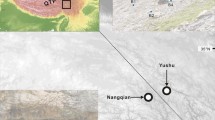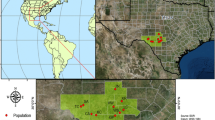Abstract
Conservation geneticists make inferences about their focal species from genetic data, and then use these inferences to inform conservation decisions. Since different biological processes can produce similar patterns of genetic diversity, we advocate an approach to data analysis that considers the full range of evolutionary forces and attempts to evaluate their relative contributions in an objective manner. Here we collect data from microsatellites and chloroplast loci and use these data to explore models of historical demography in the carnivorous Pitcher Plant, Sarracenia alata. Findings indicate that populations of S. alata exhibit high degrees of population genetic structure, likely caused by dispersal limitation, and that population sizes have decreased in western populations and increased in eastern populations. These results provide new insight to the management and conservation of plants restricted to small, declining populations isolated in increasingly scarce and highly threatened habitat, including other rare and endangered species of Sarracenia.



Similar content being viewed by others
References
Akaike H (1973) Information theory as an extension of the maximum likelihood principle. In Kotz S, Johnson NL (eds) Breakthroughs in statistics, vol 1. Springer-Verlag, London, pp 610–624
Al-Rabab’ah MA, Williams GC (2002) Population dynamics of Pinus taeda L. based on nuclear microsatellites. For Ecol Manag 163:263–271
Anderson DR (2008) Model based inference in the life sciences. Springer, New York
Baer CF (1999) Among-locus variation in Fst: fish, allozymes and the Lewontin–Krakauer test revisited. Genetics 152:653–659
Barker NG, Williamson GB (1988) Effects of a winter fire on Sarracenia alata and S. psittacina. Am J Bot 75:138–143
Bayer RJ, Hufford L, Soltis DE (1996) Phylogenetic relationships in Sarraceniaceae based on rbcL and ITS sequences. Syst Bot 21:121–134
Beaumont MA (2005) Adaptation and speciation: what can Fst tell us? Trends Ecol Evol 20:435–440
Beerli P (2006) Comparison of Bayesian and maximum likelihood inference of population genetic parameters. Bioinformatics 22:341–345
Beerli P, Felsenstein J (2001) Maximum likelihood estimation of a migration matrix and effective population sizes in n subpopulations using a coalescent approach. Proc Natl Acad Sci USA 98:4563–4568
Breed MD, McGlynn TP, Sanctuary MD, Stocker EM, Cruz R (1999) Distribution and abundance of colonies of selected meliponine species in a Costa Rican tropical wet forest. J Trop Ecol 15:765–777
Brewer JS (2005) The lack of favorable responses of an endangered pitcher plant to habitat restoration. Restor Ecol 13:710–717
Burbrink FT, Fontanella F, Pyron RA, Guiher TJ, Jimenez C (2008) Phylogeography across a continent: the evolutionary and demographic history of the North American Racer (Serpentes Colubridae: Coluber constrictor). Mol Phylogenet Evol 47:274–288
Burnham KP, Anderson DR (1998) Model Selection and inference: a practical information-theoretic approach. Springer, New York
Carstens BC, Stoute HN, Reid NM (2009) An information-theoretic approach to phylogeography. Mol Ecol 18:4270–4282
Cornuet JM, Luikart G (1996) Description and power analysis of two tests for detecting recent population bottlenecks from allele frequency data. Genetics 144:2001–2014
Dyer R (2009) GeneticStudio: a suite of programs for spatial analysis of genetic-marker data. Mol Ecol Resour 9:110–113
Ellegren H (2000) Microsatellite mutations in the germline: implications for evolutionary inference. Trends Genet 16:551–558
Ellison AM, Gotelli NJ (2001) Evolutionary ecology of carnivorous plants. Trend Ecol Evol 16:623–629
Ellison AM, Parker JN (2002) Seed dispersal and seedling establishment of Sarracenia purpurea (Sarraceniaceae). Am J Bot 89:1024–1026
Evanno G, Regnaut S, Goudet J (2005) Detecting the number of clusters of individuals using the software structure: a simulation study. Mol Ecol 14:2611–2620
Felsenstein J (1985) Confidence limits on phylogenies: an approach using the bootstrap. Evolution 39:783–791
Fischer J, Lindernmayer DB (2007) Landscape modification and habitat fragmentation: a synthesis. Glob Ecol Biogeogr 16:265–280
Fisk HN (1944) In: Engineers USACo (ed) Geological investigation of the alluvial valley of the lower Mississippi River. Mississippi River Commission, Vicksburg, MS
Fisk HN (1947) In: Engineers USACo (ed) Fine grained alluvial deposits and their effects on Mississippi River activity. Mississippi River Commission, Vickburg, MS
Foley JA, DeFries R, Asner GP, Barford C, Bonan G, Carpenter SR, Chapin FS, Coe MT, Daily GC, Gibbs HK, Helkowski JH, Holloway T, Howard EA, Kucharik CJ, Monfreda C, Patz JA, Prentice IC, Ramankutty N, Snyder PK (2005) Global consequences of land use. Science 309:570–574
Folkerts GW (1982) The Gulf Coast pitcher plant bogs. Am Sci 70:260–267
Fu YX (1997) Statistical tests of neutrality of mutations against population growth, hitchhiking and background selection. Genetics 147:915–925
Godt MJW, Hamrick JL (1998) Allozyme diversity in the endangered pitcher plant Sarracenia rubra ssp. alabamensis (Sarraceniaceae) and its close relative S. rubra ssp. rubra. Am J Bot 85:802–810
Gomez B, Mertes LAK, Phillips JD, Magilligan FJ, James LA (1995) Sediment characteristics of an extreme flood: 1993 upper Mississippi River valley. Geology 23:963–966
Hahn MW, Rausher MD, Cunningham CW (2002) Distinguishing between selection and population expansion in an experimental lineage of bacteriophage T7. Genetics 161:11–20
Haila Y (2002) A conceptual genealogy of fragmentation research: from island biogeography to landscape ecology. Ecol Appl 12:321–334
Hey J, Nielsen R (2004) Multilocus methods for estimating population sizes, migration rates, and divergence times, with applications to the divergence of Drosophila pseudoobscura and D. persimilis. Genetics 167:747–760
Hey J, Nielsen R (2007) Integration within the Felsenstein equation or improved Markov chain Monte Carlo methods in population genetics. Proc Natl Acad Sci USA 104:2785–2790
Hobbs RJ, Yates CJ (2003) Impacts of ecosystem fragmentation on plant populations: generalising the idiosyncratic. Aust J Bot 51:471–488
Huelsenbeck JP, Huelsenbeck ET, Andolfatto P (2007) Structurama: Bayesian inference of population structure. Bioinformatics (in press)
Jensen JL, Bohonak AJ, Kelley STBGv (2005) Isolation by distance, web service. BMC Genet 6:13
Keddy PA, Smith L, Campbell DR, Clark M, Montz G (2006) Patterns of herbaceous plant diversity in southeastern Louisiana pine savannas. Appl Veg Sci 9:17–26
Kliman RM, Andolfatto P, Coyne JA, Depaulis F, Kreitman M, Berry AJ, McCarter J, Wakeley J, Hey J (2000) The population genetics of the origin and divergence of the Drosophila simulans complex species. Genetics 156:1913–1931
Koopman MM, Gallagher E, Carstens B, Consortium MERPD (2009) Isolation and characterization of nine microsatellite loci in the Pale Pitcher Plant Sarracenia alata (Sarraceniaceae). Mol Ecol Resour 9:1460–1466
Kreyer D, Oed AA, Walther-Hellwig K, Frankl R (2004) Are forests potential landscape barriers for foraging bublebees? Landscape scale experiments with Bombus terrestris agg. and Bombus pascuaorum (Hymenoptera, Apidae). Biol Conserv 116:111–118
Kuhner MK (2006) LAMARC 2.0: maximum likelihood and Bayesian estimation of population parameters. Bioinformatics 22:768–770
Lewontin RC, Krakauer J (1973) Distribution of gene frequency as a test of theory of selective neutrality of polymorphisms. Genetics 74:175–195
Librado P, Rozas J (2009) DnaSP v5: a software for comprehensive analysis of DNA polymorphism data. Bioinformatics 25:1451–1452
Machado CA, Hey J (2003) The causes of phylogenetic conflict in a classic Drosophila species group. Proc R Soc Lond B 270:1193–1202
MacRoberts MH, MacRoberts BR (1991) The distribution of Sarracenia in Louisiana, with data on its abundance in the western part of the state. Phytologia 70:119–125
MacRoberts BR, MacRoberts MH, Stacey L (2001) Florisitcs and management of pitcher plant bogs in northern Natchitoches and Winn Parishes, Louisiana. Proc La Acad Sci 64:14–21
Mantel N (1967) The detection of disease clustering and a generalized regression approach. Cancer Res 27:209–220
Marriage TN, Hudman S, Mort EM, Orive ME, Shaw RG, Kelly JK (2009) Direct estimation of the mutation rate at dinucleotide microsatellite loci in Arabidopsis thaliana (Brassicaceae). Heredity 103:310–317
McDaniel S (1971) The genus Sarracenia (Sarraceniaceae). Bull Tall Timbers Res Stat 9:36
Minin V, Abdo Z, Joyce P, Sullivan J (2003) Performance-based selection of likelihood models for phylogeny estimation. Syst Biol 52:674–683
Murray GE (1961) Geology of the Atlantic and Gulf Coastal Province of North America. Harper & Brothers, New York, NY
Near NJ, Page LM, Mayden RL (2001) Intraspecific phylogeography of Percina evides (Percidae: Etheostomatinae): an additional test of the Central Highlands pre-Pleistocene vicariance hypothesis. Mol Ecol 10:2235–2240
Nickerson RS (1998) Confirmation bias: a ubiquitous phenomenon in many guises. Rev Gen Psychol 2:175–220
Nielsen R, Wakeley J (2001) Distinguishing migration from isolation: a markov chain monte carlo approach. Genetics 158:885–896
O’Neil W (1983) A preliminary reposrt on the pollination of Sarracenia purpurea in the forest-swale ecotone. Carniv Plant Newsl 12:60–62
Osborne JL, Martin AP, Carreck NL, Swain JL, Knight ME, Goulson D, Hale RJ, Sanderson RA (2008) Bumblebee flight distances in relation to the forage landscape. J Anim Ecol 77:406–415
Pritchard JK, Wen W (2004) Documentation for the STRUCTURE software Version 2. Chicago
Pritchard JK, Stephens M, Donnelly P (2000) Inference of population structure using multilocus genotype data. Genetics 155:945–959
Raymond M, Rousset F (1995) GENEPOP (version 1.2): population genetics software for exact tests and ecumenicism. J Hered 86:248–249
Saucier RT (1994) In: Engineers USACo (ed) Geomorphology and quaternary geologic history of the lower Mississippi Valley. Mississippi River Commission, Vicksburg, MS
Schnell DE (1976) Carnivorous plants of the United States and Canada, Second edn. Timber Press, Portland, Oregon
Schwaegerle KE (1983) Population growth of the pitcher plant, Sarracenia purpurea L., at Cranberry Bog, Licking County, Ohio. Ohio J Sci 1:19–22
Schwaegerle KE, Schaal BA (1979) Genetic variability and founder effect in the pitcher plant Sarracenia purpurea. Evolution 33:1210–1218
Shaw J, Lickey EB, Beck JT, Farmer SB, Liu W, Miller J, Siripun KC, Winder CT, Schilling EE, Small RL (2005) The tortoise and the hare II: relative utility of 21 noncoding chloroplast DNA sequences for phylogenetic analysis. Am J Bot 92:142–166
Shaw J, Lickey EB, Schilling EE, Small RL (2007) Comparison of whole chloroplast genome sequences to choose noncoding regions for phylogenetic studies in angiosperms: the tortoise and the hare III. Am J Bot 94:275–288
Sheridan PM (1991) What is the identity of the West Gulf Coastal pitcher plant, Sarracenia alata?. Carniv Plant Newsl 20:102–110
Slack A (1979) Carnivorous plants. MIT Press, Cambridge, MA
Slatkin M (1981) Estimating levels of gene flow in natural populations. Genetics 99:323–335
Soltis DE, Morris AB, McLachlan JS, Manos PS, Soltis PS (2006) Comparative phylogeography of unglaciated eastern North America. Mol Ecol 15:4261–4293
Storz JF (2005) Using genome scans of DNA polymorphism to infer adaptive population divergence. Mol Ecol 14:671–688
Swofford DL (2001) PAUP*. Phylogenetic analysis using parsimony (*and other methods). Version 4. Sinauer Associates, Sunderland, Massachusetts
Thuillet A, Bru D, David J, Roumet P, Santoni S, Sourdille P, Bataillon T (2002) Direct estimation of mutation rate for 10 microsatellite loci in Durum Wheat, Triticum turgidum (L.) Thell. ssp durum. Mol Biol Evol 19:122–125
Van Oosterhout C, HW F, WDP M, Shipley P (2004) MICRO-CHECKER: software for identifying and correcting genotyping errors in mirosatellite data. Mol Ecol Notes 4:535–538
Vigouroux Y, Jaqueth JS, Matsuoka Y, Smith OS, Beavis WD, Smith JSC, Doebley J (2002) Rate and Pattern of Mutation at Microsatellite Loci in Maize. Molecular Biology and Evolution 19:1251–1260
Visscher PK, Seeley TD (1982) Foraging strategy of honey bee colonies in a temperate deciduous forest. Ecology 63:1790–1801
Wang ZF, Hamrick JL, Godt MJW (2004) High genetic diversity in Sarracenia leucophylla (Sarraceniaceae), a carnivorous wetland herb. J Hered 95:234–243
Watterson GA (1984) Allele frequencies after a bottleneck. Theor Popul Biol 26:387–407
Weir BS, Cockerham CC (1984) Estimating F-statistics for the analysis of population structure. Evolution 38:1358–1370
Weiss TE (1980) The effects of fire and nutrient availability on the pitcher plant Sarracenia flava L. University of Georgia, Athens
Wherry ET (1929) Acidity relations of the Sarracenias. Wash Acad Sci 19:379–390
Wright S (1969) Evolution and the genetics of populations. University of Chicago Press, Chicago
Acknowledgments
Funding was provided by the Louisiana State University Faculty Research Program and the Louisiana Board of Regents Research Competitiveness Subprogram (33825). We thank S. Hird for collecting S. alata material, V. Smith and M. Olinde for assistance with collection permits, and D. Fuselier and E. Gallagher for help in the lab. We thank L. Urbatch for helpful discussions related to this work.
Author information
Authors and Affiliations
Corresponding author
Rights and permissions
About this article
Cite this article
Koopman, M.M., Carstens, B.C. Conservation genetic inferences in the carnivorous pitcher plant Sarracenia alata (Sarraceniaceae). Conserv Genet 11, 2027–2038 (2010). https://doi.org/10.1007/s10592-010-0095-7
Received:
Accepted:
Published:
Issue Date:
DOI: https://doi.org/10.1007/s10592-010-0095-7




